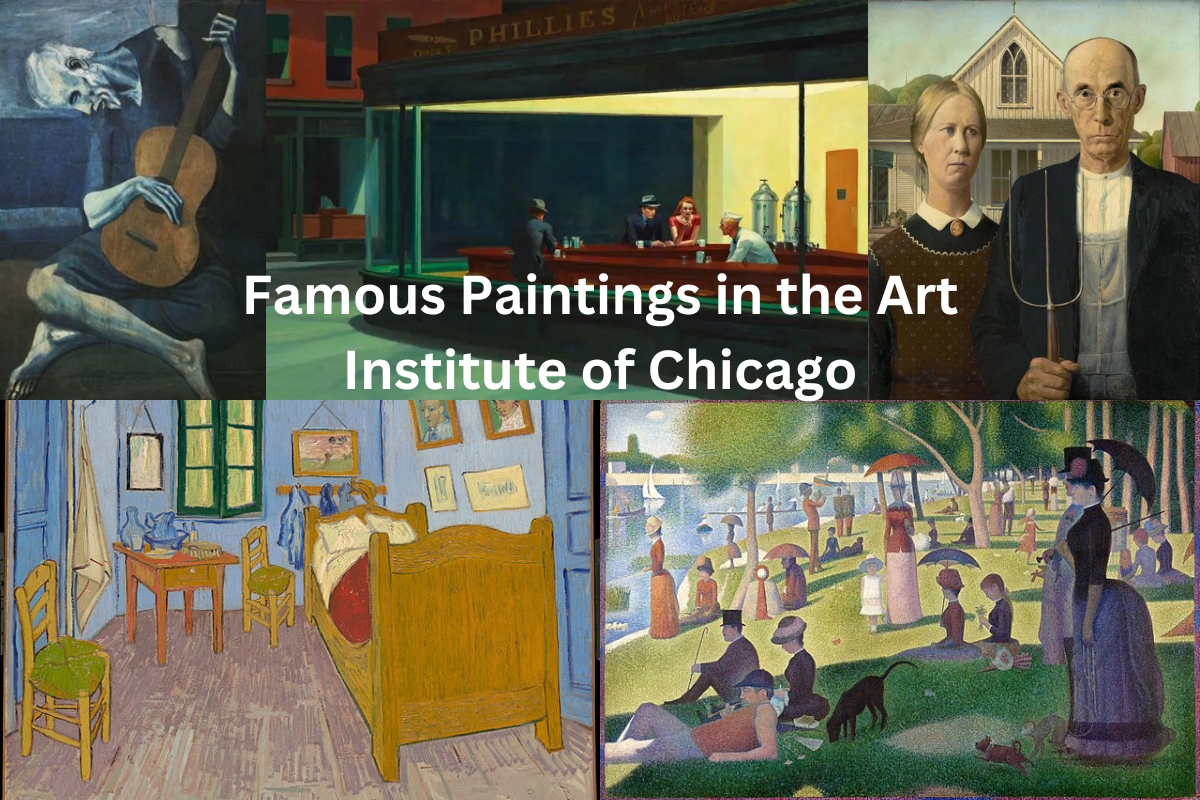The Art Institute of Chicago, which has been around since 1879 and is located in Grant Park in Chicago, is both one of the world’s oldest and largest art museums.
The museum is frequented by around 1.5 million people on an annual basis, earning it acclaim for both its curatorial work and its appeal among guests.
Its collection is encyclopedic, and it contains well-known works such as:
- “A Sunday on La Grande Jatte” by Georges Seurat
- “The Old Guitarist” by Pablo Picasso
- “Nighthawks” by Edward Hopper
- “American Gothic” by Grant Wood.
The collection is overseen by 11 different curatorial departments.
Its permanent collection contains close to 300,000 works of art, and each year it mounts more than thirty special exhibitions that shed light on various elements of the collection and feature cutting-edge curatorial and scientific research.
The expansion of the collection has made it necessary for the museum to make a number of extensions to its original building, which was completed in 1893 for the World’s Columbian Exposition.
The museum’s most recent addition, the Modern Wing, which was designed by Renzo Piano and opened in 2009, increased the museum’s footprint to nearly one million square feet, which elevated it to the position of the second-largest art museum in the United States, behind only the Metropolitan Museum of Art.
One of the few remaining united arts organizations in the United States, the Art Institute of Chicago is affiliated with the School of the Art Institute of Chicago, which is widely regarded as one of the best art schools in the country.
Famous Paintings in the Art Institute of Chicago
1. American Gothic – Grant Wood
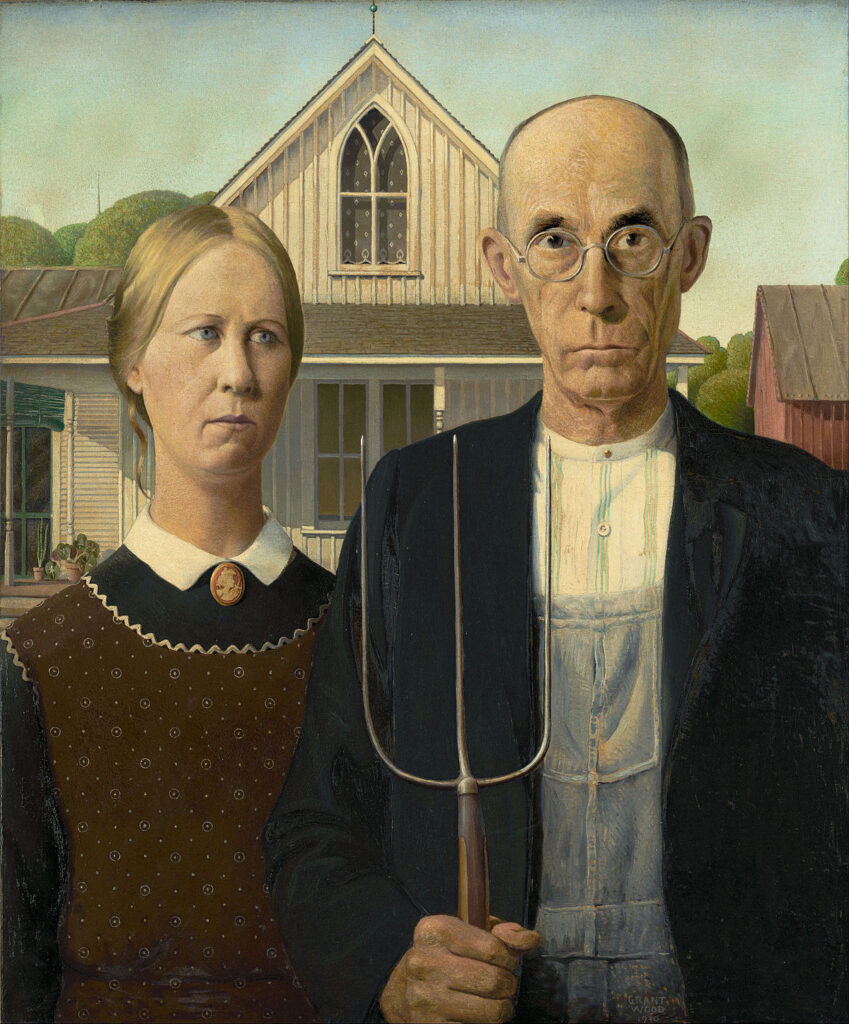
The painting “American Gothic” by Grant Wood is considered to be one of the most iconic examples of works of art created in the United States. The picture depicts two mournful characters standing in front of a simple farmhouse.
The severity that the people of the United States were forced to face during the Great Depression of the 1920s is made abundantly clear by the piece, which was painted in 1930 and bears the year’s title.
It is the epitome of art that is characterized as social realism. The artwork by Wood depicts a house with a one-of-a-kind design that presented what Wood perceived to be an architectural appearance in the Gothic style.
After generating sketches of the house, Wood employed his dentist and his sister as a solemn father and daughter standing diligently in front of their farmhouse. This was done after Wood had developed drawings of the house.
The work is a reflection of the hardworking American spirit, which was something that the people of the country took great pleasure in. The work of Wood was immediately hailed as a classic, and it has since evolved into one of the most recognizable examples of artistic achievement in American popular culture.
2. A Sunday Afternoon on the Island of La Grande Jatte – George Seurat
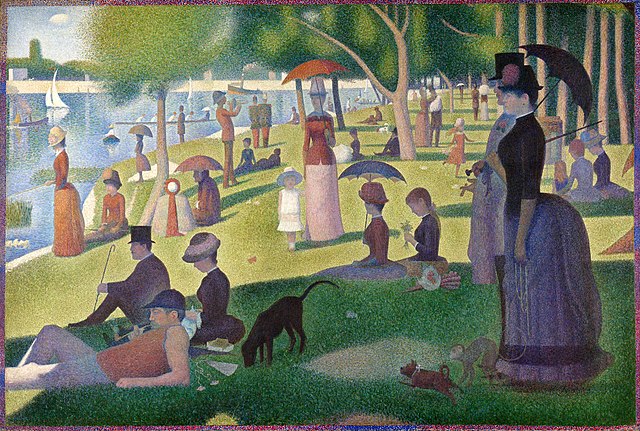
Georges Seurat is recognized to have created many of the works that critics, historians, and scholars regard to be among the greatest masterpieces of the pointillism style. He is believed to be the father of the pointillism movement and is known to have created many of the works.
In the first part of his career, he painted in a manner that would be analogous to that of the majority of other Impressionist painters; nevertheless, as his life progressed, he started to experiment with a variety of approaches to the aesthetic representation of his ideas.
The painting “Sunday on the Island of La Grande Jatte” is considered by many art experts and historians to be among the most important and influential works produced during the era it depicts. It is also considered to be one of the greatest masterpieces created by Seurat.
Seurat is believed to have spent about two full years working on the painting before it was totally completed. The painting was finished in the year 1886.
The focus of the work is on a topic that offers a voyeuristic look into the ways in which members of French society spent their time at leisure in the middle to late 19th century. On a bright and sunny day, it shows a scene of people lazing around on the banks of the Seine.
3. Nighthawks – Edward Hopper
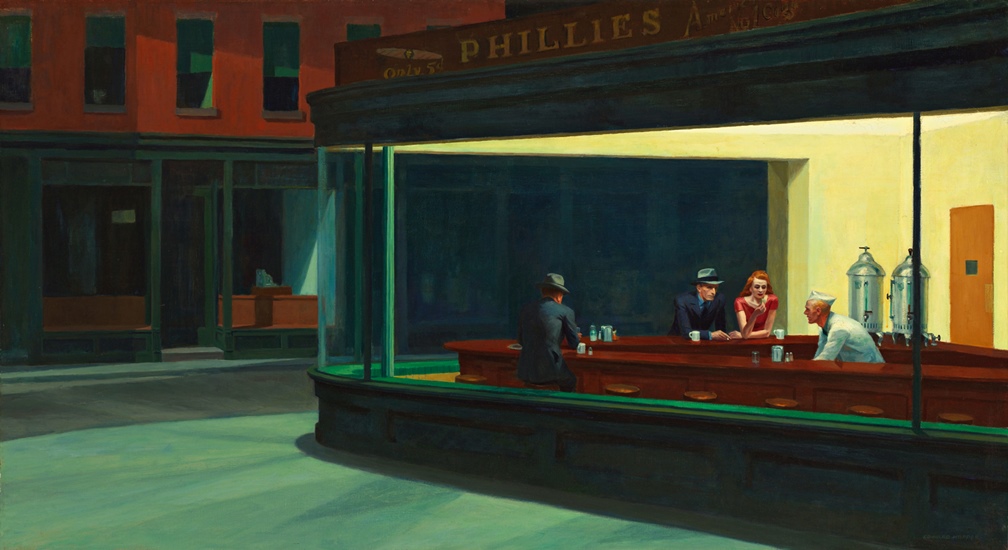
Edward Hopper painted Nighthawks in 1942 using oil on canvas. The scene depicted in the picture shows four people sitting in a downtown diner late at night as viewed through the big glass window of the establishment. The light from the diner sheds some brightness on the otherwise dark and deserted urban landscape.
It is believed to be Hopper’s most famous piece of work and is widely regarded as one of the most iconic paintings in the history of American art. Only a few short months after it was finished, on May 13, 1942, it was transferred to the Art Institute of Chicago in exchange for the sum of $3,000.
It is said that Hopper got the idea for the scenario from a restaurant that no longer exists in Hopper’s neighborhood of Greenwich Village in Manhattan.
Hopper claims that he was motivated to paint the scene after visiting “a café on Greenwich Avenue where two streets converge.” In addition to that, he stated, “I streamlined the situation quite a bit and made the restaurant bigger.”
4. The Old Guitarist – Vincent van Gogh
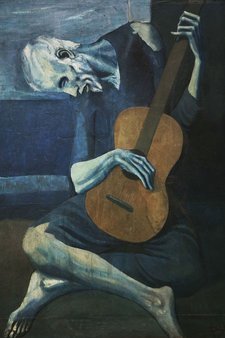
It is said that Picasso spent the majority of his life in abject poverty, and that it was during this time that he developed a deep empathy for others who were suffering from poverty and oppression around the world.
Picasso is thought to have been residing in Barcelona at the time of the creation of The Old Guitarist (1903), which occurred during a time when the artist was close to becoming bankrupt.
This period of time has been nicknamed his “Blue” phase, when he painted practically every painting in a drab monochromatic palette of blue, a color that fit the kind of subject matter that he would discuss. Blue was a hue that matched the kind of subject matter that he would address.
Picasso produced this work not long after his close friend Casagemas took his own life as the result of a protracted battle with mental illness and depression.
This work, along with others that the artist produced during this time period, was created with the intention of the artist focusing on people who are frequently suffocated and burdened by the concerns and troubles that so frequently consume humanity.
The viewer has an intense impression of desolation while viewing the picture as a whole due to the usage of a dark blue color over the entire piece.
The man in the picture is shown clutching a guitar and appears to be performing a sad tune, as evidenced by the expression of anguish and desolation on his face.
Art historians and art critics agree that Picasso’s masterful use of the color blue is responsible for appropriately imposing the sensation of melancholy that so many people perceive while looking at this piece.
While the guitarist appears disheartened and slouched over, the guitar provides a contrast to the muted blue’s practically two-dimensional patterns that are nearly flat and monochrome.
X-rays taken of the painting at a later date revealed the presence of a ghostly figure (a lady) that Picasso had began to paint but then abandoned because he decided to cover her up with another layer of paint.
5. Sky above Clouds IV, 1965 – Georgia O’Keeffe
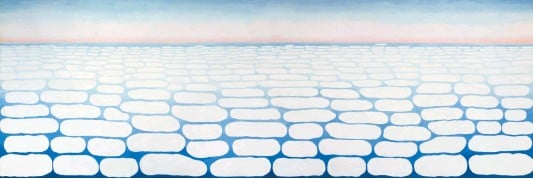
Georgia O’Keeffe completed a series of massive paintings in the 1960s centered on the subject of clouds. Sky Above Clouds IV is the final monumental painting in the series.
She created this ethereal absorption in the sky-scape using her developed, abstract technique, which oscillates between pattern and landscape.
In the early 1960s, Georgia O’Keeffe began to paint the vast, unending stretches of cloud cover that she had seen from the windows of airplanes while traveling all over the world.
A retrospective of O’Keeffe’s artwork was going to be held at the Whitney Museum of American Art in New York, the Art Institute of Chicago, and the San Francisco Museum of Art, and Sky above Clouds IV was going to be one of the paintings that was going to be displayed there.
After having been exhibited in New York and Chicago, it was determined that the artwork could not fit through the doors of the museum in San Francisco because it was too huge.
Therefore, it was kept on loan at the Art Institute of Chicago for over a decade while the artist and collectors of her work who have a concern for the public good made arrangements for it to become part of the permanent collection at the museum.
6. Bedroom in Arles, version 3 – Vincent van Gogh
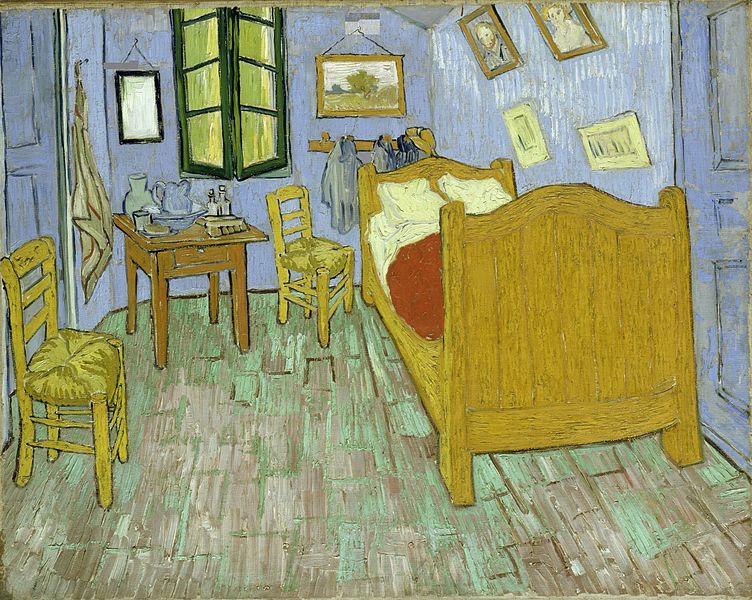
This piece was originally titled “The Bedroom” by Van Gogh himself. In the letters that he wrote to his brother Theo, he described three different accounts that were accurate.
Bedroom in Arles (French: La Chambre à Arles; Dutch: Slaapkamer te Arles) is the title of three paintings created by Vincent van Gogh that are all connected to one another.
The paintings are easily distinguished from one another because to the photographs that are hung on the wall to the right of each canvas.
According to the findings of recent studies, the deterioration that occurs over time is responsible for giving modern artworks their strikingly contrasting color schemes. For instance, the walls and doors used to be purple rather than blue when they were first built.
Van Gogh removed the shadows from the painting so that it would conform to the aesthetic that he had been observing in the Japanese prints that he had been analyzing.
The absence of shadows along with the skewed perspective gives the appearance that numerous of the objects are about to topple over or are unstable.
This is not entirely attributable to a lack of expertise on anyone’s part or an urge to get things done as quickly as possible. The odd angle formed by the building’s outer walls prevents the furnishings from being arranged in an orderly fashion inside the space.
7. Two Sisters (On the Terrace) – Pierre-Auguste Renoir
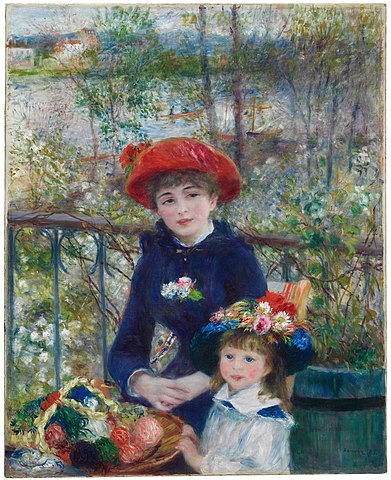
In the picture titled “Two Sisters,” an older girl is depicted sitting with her younger sister.
The smaller of the two girls wears a flower crown, but the older of the two wears a red hat and a blue blazer. Both of them have a flower basket in hand as they take in the view of the river from the terrace where they are sitting.
The luncheon of the boating party takes place on the terrace of the Maison Fournaise, which is a restaurant located on an island in the Seine. The terrace also serves as the location of the luncheon.
The background is hazy, as it is in previous works by Renoir; the trees and the water seem to merge together, and the viewer can only make out isolated parts of the landscape beyond. In the spring of 1882, it was displayed at the 7th Impressionist Exhibition that was held in Paris.
8. Paris Street; Rainy Day – Gustave Caillebotte
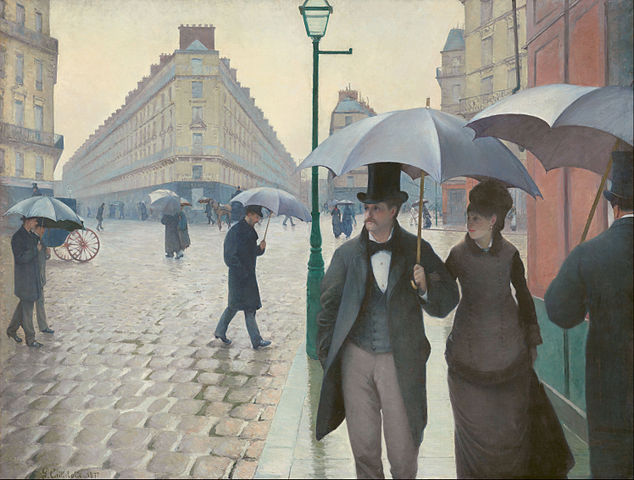
The enormous oil painting on canvas titled Paris Street on a Rainy Day that Gustave Caillebotte (1848–1894) created in 1877 is the artist’s most famous work.
It depicts a group of individuals making their way through the Place de Dublin, which was formerly known as the Carrefour de Moscou. This intersection is located in the north of Paris, east of the Gare Saint-Lazare.
Even though Caillebotte was a friend and patron of a great number of impressionist artists, and even though this work is considered to be a part of that school, it is distinct in its realism and its attention on line rather than on sweeping brush strokes.
The interest that Caillebotte had for photography is very obvious. The qualities of the people in the foreground appear to be “out of focus,” while those in the middle distance (the carriage and pedestrians at the crossroads) have sharp edges, and the details of the people in the background become increasingly hazy.
The influence of photography is demonstrated by the harsh cropping of various characters, most notably the individual located on the extreme right.
The year 1877 marked the premiere of the painting at the Third Impressionist Exhibition. It is currently owned by the Art Institute of Chicago.
9. At the Moulin Rouge – Henri de Toulouse-Lautrec
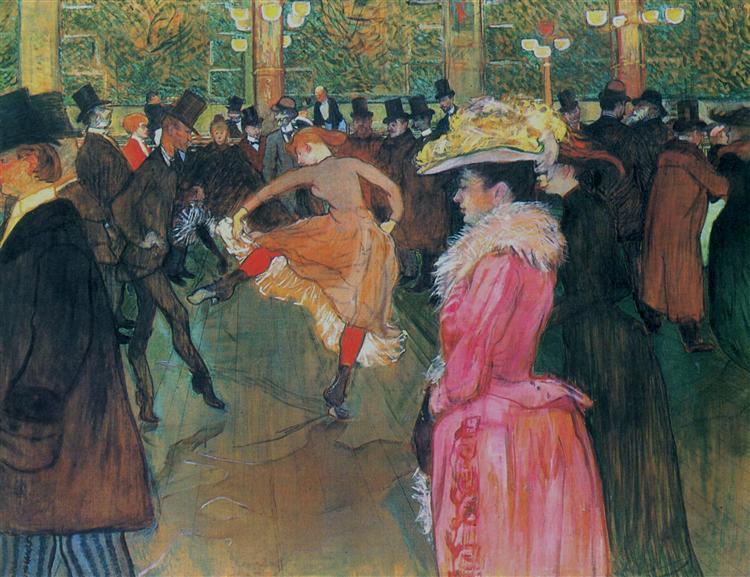
Henri de Toulouse-Lautrec is the artist behind the oil on canvas artwork titled “The Dance at the Moulin Rouge.” It is the second of Toulouse-paintings Lautrec’s depicting the Moulin Rouge cabaret, which first opened its doors in Paris in 1889 and was depicted here in 1890 when it was made.
In the middle of a lively dance hall, it shows two dancers performing the can-can. A previously discovered inscription by Toulouse-Lautrec can be seen written on the reverse of the piece of artwork.
It says, “The teaching of the new ones by Valentine the Boneless.” This leads one to believe that the gentleman standing to the left of the woman who is dancing is Valentin le désossé, a well-known dancer at the Moulin Rouge who is currently teaching the cabaret’s newest member how to dance.
A peculiar aristocratic lady dressed in pink may be seen to the right. A large number of aristocratic characters, such as the poet Edward Yeats, the club owner, and even Toulouse-father, emerge in the background of the scene.
10. America Windows – Marc Chagall
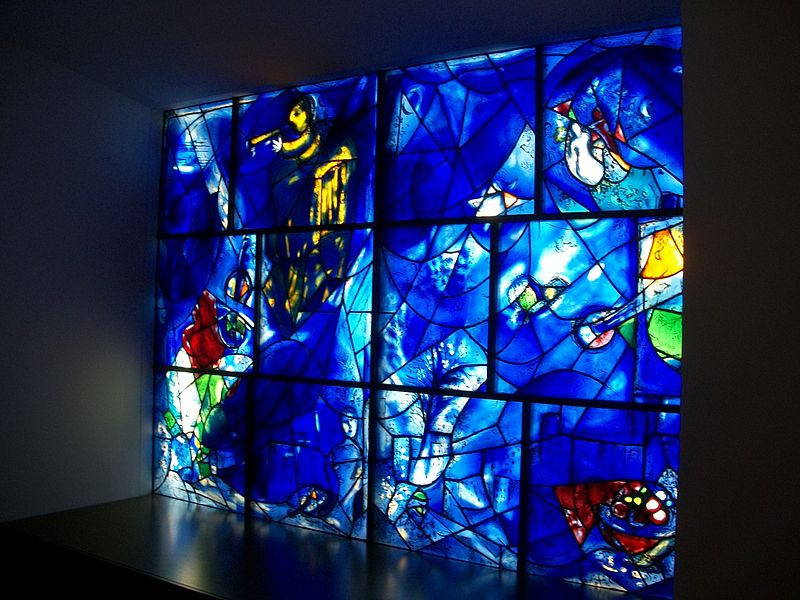
In 1977, in honor of the United States Bicentennial, the “America Windows” painting by Marc Chagall was given as a donation to the Art Institute of Chicago.
The first panel takes a deep dive into the illustrious history of Chicago as a center for rhythm and blues music. In the second panel, we get an illustration of the harmony and togetherness that can be found in the city’s many different communities. Finally, the significance of having freedom of religion in the United States is represented by the third panel.
The “Chagall Windows,” as they are more often known, have a very special place in the hearts of Chicago residents because of their presence in the film “Ferris Bueller’s Day Off,” which was released less than ten years after the windows were installed.
In Gallery 144, bask in the radiance of this magnificent art that was created using six panels.
11. Portrait of Pablo Picasso – Juan Gris
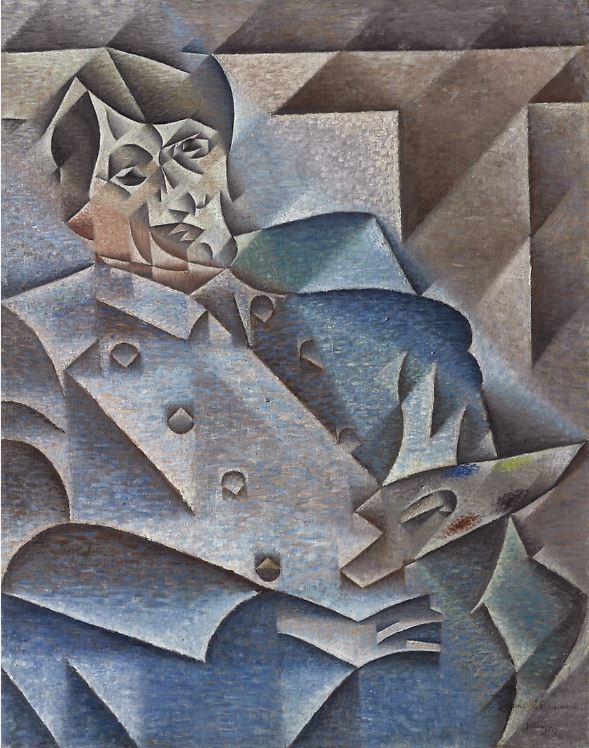
There are not many portraits that are historically famous not only for their subject but also for the quality of the portrait.
The painting titled Portrait of Pablo Picasso by Juan Gris is an example of this type of work since it depicts the illustrious Spanish painter Pablo Picasso in a relaxed position that provides the viewer with a tempting image that contains increasing levels of color contrast and light contrast.
This picture, which Gris completed in 1912, is widely regarded as one of the most well-known examples of his work. Gris is claimed to have been close friends with Picasso.
The delicate geometric shapes used in the painting provide an unusual amount of attention to the various levels of light and how the darkness fades into other sections to create an image of the great painter in a comfortable state.

